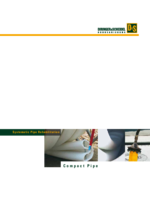The product
Compact Pipe is manufactured as a standard pipe in accordance with the DIN 8074 standard with corresponding wall thicknesses. The product already receives the typical deformation during production in the factory. For this purpose, the HDPE pipe is axially folded into a c-shape under defined conditions.
For winding and installation reasons, the fold is on the side of the pipe. The resulting reduction in cross-section of up to 35% makes it easier to pull the pipe through existing manholes or into the pipe to be rehabilitated. Depending on the nominal diameter, several hundred metres can be wound and pulled in on a drum.
The field of application
Compact Pipe is suitable for the rehabilitation of water pipes, industrial pipelines, gas pipes and sewer pipes made of materials such as steel, cast iron, ceramic or concrete. In a nominal width range from DN 100 to DN 500.
The installation
When Compact Pipe is used, an HDPE pipe pre-formed into a c-shape during production at the factory is drawn into a cleaned position. Pressure and heat then ensure that the PE pipe lies "close-fit" to the inner wall of the old pipe due to the so-called memory effect.
The advantages
The close-fit lining system is particularly advantageous in situations where the inaccessibility of the structures, high traffic densities or elaborate superstructures prohibit renovation using the open construction method. Renovation with Compact Pipe is renovation with the quality of a new installation. The result is a structurally independent and resilient pipe that effortlessly meets even strict economic criteria. In addition to the short installation time, other advantages include the fact that, in contrast to open-trench pipe construction, excavations are generally unnecessary. This keeps the disturbances for residents as well as pedestrian and road traffic within acceptable limits.
The product
The new CP-ZA 2012 hat profile is a joint development of Diringer & Scheidel Rohrsanierung and the Compact Pipe System manufacturer. It is used as a supplementary system method in the renewal of pipes that have been rehabilitated using the Compact Pipe method. The hat profile consists of a flexible textile hose impregnated with resin and a HDPE brim with a heating coil and special sealing elements.
The field of application
The CP-ZA 2012 hat profile is used for the subsequent connection of inlets in closed design. The cap profile connects pipes and inlets in gravity lines which have been renewed with a PEHD liner. With a length of up to 40 cm, it covers the first socket in the connection duct or house connection. The CP-ZA 2012 can be used for inlets in nominal sizes DN 100 to DN 200 and for main collectors from DN 250 to DN 500.
The installation
Robot setting tools are used to install the hat profile from the main collector with nominal widths from DN 250 to DN 500 into the connection duct or house connection and connect it to these with positive and non-positive fit. At the point of installation, the PEHD brim is pressed against the pipe wall at the specified pressure and connected to the Compact-Pipe pipe with the same material by means of a heating spiral in compliance with the specified heating parameters. All system-relevant parameters are documented. The flexible textile hose, which is firmly connected to the PEHD brim, is impregnated with resin and put into the connecting duct with the aid of a flexible bladder. The laminate is then cured by the ambient temperature (cold). As a result, after the flexible textile hose has cured, a tightly bonded connection is obtained. Connections that do not open at right angles can also be integrated with this process.
![[Translate to English:] Diringer & Scheidel Rohr [Translate to English:] Logo Diringer & Scheidel Rohr](/fileadmin/media/logos/DuS_Rohr_GmbH_u_Co_KG.svg)

